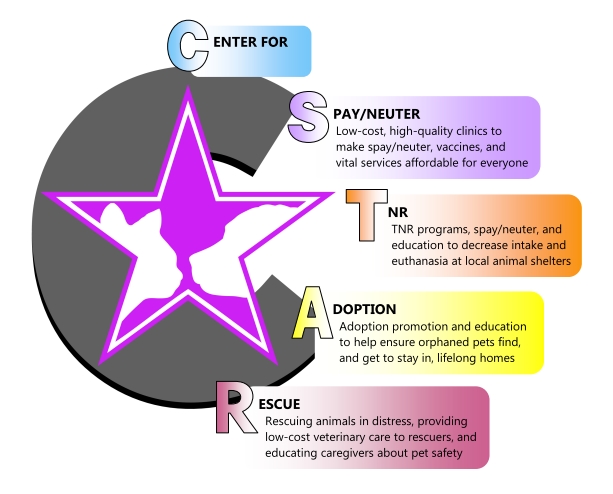

About CSTAR Animal Care And The Spay Our Strays Clinic
CSTAR Animal Care is a 501(c)(3) nonprofit organization that was started in 2012 in an effort to expand the animal welfare services offered to local communities. CSTAR's primary areas of focus are low-cost spay/neuter and TNR education and services through its Spay Our Strays Clinic program.
 |
In addition to providing low-cost spay/neuter, vaccinations, and other vital veterinary services, CSTAR works with many local municipalities, animal shelters, rescues, and other animal welfare groups, promoting adoptions and providing education/information on many topics such as how to fix/cope with stray and feral cats, Trap-Neuter-Return (TNR) programs and traps, how to get rid of fleas, how to introduce new pets, the benefits of spay/neuter surgery, and the importance of veterinary wellness care.
CSTAR's Vision And Mission Statements
CSTAR's Vision
An environment where euthanasia is no longer used, or even deemed necessary, to manage the size of the region's feline and canine population, and where cats and dogs no longer suffer and die from untreated or preventable diseases, illnesses, and injuries.
CSTAR's Mission
To end the needless suffering and avoidable deaths of cats and dogs, in Southern NJ and the surrounding areas, by providing affordable, high-quality veterinary services and effective, non-lethal alternatives to euthanasia, centered around low-cost spay/neuter surgery, vaccinations, and education.
CSTAR's Spay Our Stray Clinic - History And Stats
The Spay Our Strays Clinic program was started in 2007 and was initially offered through Camden County Animal Shelter to residents of Camden County only. From 2007 through 2012, more than 6,500 cats were fixed in just 56 clinics, reaching more than 2,500 different caregivers, and fixing an average of 125 cats per clinic. But, this just wasn't enough for the clinic volunteers because there were still so many people in neighboring communities that also needed these low-cost services.
So, in 2013, the entire Spay Our Strays Clinic program moved to CSTAR Animal Care. The clinic continues to be led by its original founder and coordinator and is still staffed by many of the same volunteers, veterinary technicians, and veterinarians who have been providing clinic caregivers with the highest quality of service for years. These dedicated, hard-working members of CSTAR Animal Care, along with many new additions to our clinic program, have enabled us to grow the clinic program into the success it is today.
After becoming a part of CSTAR Animal Care, the Spay Our Strays Clinic program was immediately expanded to include all residents, rather than being limited to residents of just one county. While the clinic's primary target areas are its surrounding communities of Camden, Gloucester, and Burlington counties, CSTAR's low-cost clinics are open to everyone, and they have been utilized by caregivers from all different parts of Northern, Central, and Southern New Jersey, as well as by residents of neighboring states.
CSTAR also significantly updated the clinic program to ensure low-cost clinic services were available for all cats and dogs rather than just the cats in need of spay/neuter appointments. Caregivers were finally able to schedule follow-up and continuing care appointments at the Spay Our Strays Clinic for cats that had already been spayed/neutered, but who still needed other clinic services such as booster vaccines, microchips, parasite treatments, FIV/FeLV testing, etc. And, low-cost veterinary services for dogs were finally incorporated into the previously "cat only" clinics, including 5 different canine vaccines, microchips, parasite treatments, and more.
During the clinic's first few months with CSTAR Animal Care, new services continued to be added such as heartworm/lyme disease testing and heartworm preventives for dogs, feline leukemia vaccinations for cats, and nail trimming lessons for caregivers (so they could have an easy and safe alternative to declawing to maintain their cats' nails). By the end of 2013, in just 9 clinics with CSTAR Animal Care, 880 cats were spayed/neutered and over 1,000 cats and dogs were helped.
In January of 2014, CSTAR doubled the number of clinics offered with the incorporation of monthly vaccine clinics, which quickly evolved into mini spay/neuter clinics as CSTAR once again expanded its list of vital services with the addition of low-cost canine spay/neuter surgery.
But, even with twice as many clinics on the calendar, the spay/neuter and non-surgical appointment slots continued to fill up very quickly as more and more caregivers started bringing their animals back for follow-up visits for services such as booster vaccinations.
And by the end of 2015, through more than 4,700 initial and follow-up appointments in just 51 clinics, CSTAR had provided low-cost veterinary services for 3,952 cats and dogs. CSTAR had also crossed dog and cat spay/neuter surgery milestones reaching a total of 105 dogs and 3,084 cats spayed/neutered.
In August of 2016, the total number of cats spayed/neutered by CSTAR had grown to 3,612 cats, which meant that since the program began almost 10 years earlier, a total of 10,114 cats had been spayed/neutered at the Spay Our Strays Clinic.
Just before losing the Lindenwold location in December of 2016, CSTAR had already made it possible for more than 1,500 caregivers to get veterinary care such as spay/neuter surgery, initial vaccinations, booster vaccinations, and so much more for over 5,200 animals through 6,872 appointments in just 69 clinics.
And, despite a difficult start in 2017, when we had no location for the clinic for 4 months, by the summer, we found ourselves holding our 2 largest mega clinics yet. On 7/30/2017, we spayed/neutered 178 cats and provided non-surgical services to an additional 75 animals, and on 9/10/17, we fixed 160 cats plus provided another 71 cats and dogs with vaccines and other services.
By the end of 2017, through more than 8,600 initial and follow-up appointments in just 80 clinics, CSTAR provided low-cost veterinary services for 6,388 cats and dogs, including the 4,920 cats and 190 dogs that had now been spayed/neutered at the Spay Our Strays Clinic since the program moved to CSTAR in 2013.
And now, since the end of 2018, through more than 10,500 initial and follow-up appointments in 96 clinics, CSTAR has helped over 2,000 caregivers provide high-quality, low-cost, essential veterinary services for their pets, newly adopted/rescued stray cats, and free-roaming cat colonies. Additionally, CSTAR has provided low-cost veterinary services for more than 7,600 cats and dogs, including the 5,983 cats and 244 dogs that were spayed/neutered at the clinic since the program moved to CSTAR in 2013. That means over the last 12 years since the program's inception, a total of 12,485 cats have been spayed/neutered at the Spay Our Strays Clinic.
And on March 10, 2019, we are looking forward to holding CSTAR's 100th Spay Our Strays Clinic.
During the clinic's first year with CSTAR Animal Care, almost 1,200 more cats were fixed and almost 400 more caregivers were helped. Additionally, during this first year, CSTAR significantly expanded the list of services offered at the clinics. Feline leukemia vaccinations for cats and nail trimming lessons for caregivers (so they have an easy and safe alternative to declawing to maintain their cats' nails) were added to the services list. And, services for dogs were also incorporated into the previously "cat only" clinics, including 5 different vaccinations, heartworm and lyme disease testing, microchipping, and more.
In 2014, CSTAR doubled the number of clinics offered with the incorporation of monthly vaccine clinics, which quickly evolved into mini spay/neuter clinics as CSTAR expanded its services once again to now include canine spay/neuter surgery. By the end of 2014, more than 3,000 appointments and 31 clinics later, CSTAR had provided low-cost veterinary services for over 2,600 cats and dogs. Around 400 of those appointments were follow-up services such as booster vaccinations for animals that had been to see us in the past, and the rest were first-time patients, many of whom had never been to a veterinarian and would not have otherwise been able to receive these services, because their caregivers could not afford the usual cost of spay/neuter surgery and vaccinations.
At the end of 2015, after the conclusion of CSTAR's third year of Spay Our Strays Clinics, CSTAR had provided low-cost veterinary services for 3,952 cats and dogs, including the 3,084 cats and 105 dogs that had now been spayed or neutered at the clinic since it moved to CSTAR in 2013. And, through more than 4,700 appointments in just 51 clinics, we helped more than 1,100 caregivers provide high-quality, low-cost, essential veterinary services for their pets, newly adopted/rescued stray cats, and free-roaming cat colonies.
And, since the last mega clinic at the end of November 2016, through more than 6,771 appointments in just 68 clinics, CSTAR has helped almost 1,500 caregivers provide high-quality, low-cost, essential veterinary services for their pets, newly adopted/rescued stray cats, and free-roaming cat colonies. Additionally, CSTAR has provided low-cost veterinary services for 5,204 cats and dogs, including the 4,020 cats and 154 dogs that were spayed/neutered at the clinic since the program moved to CSTAR in 2013. That means over the last 10 years, a total of 10,522 cats have been spayed/neutered at the Spay Our Strays Clinic.
And, since the end of 2016, through 6,872 appointments in just 69 clinics, CSTAR has helped over 1,500 caregivers provide high-quality, low-cost, essential veterinary services for their pets, newly adopted/rescued stray cats, and free-roaming cat colonies. Additionally, CSTAR has provided low-cost veterinary services for 5,258 cats and dogs, including the 4,059 cats and 160 dogs that were spayed/neutered at the Spay Our Strays Clinic since the program moved to CSTAR in 2013. That means over the last 10 years, a total of 10,561 cats have been spayed/neutered at the Spay Our Strays Clinic.
In 2017, we had 2 of our largest mega clinics yet, fixing 178 cats and providing non-surgical services to an additional 75 animals on 7/30/2017, and fixing 160 cats plus providing another 71 cats and dogs with vaccines and other services on 9/10/17.
And, through the end of December 2017, through more than 8,600 initial and follow-up appointments in just 80 clinics, CSTAR has helped almost 1,800 caregivers provide high-quality, low-cost, essential veterinary services for their pets, newly adopted/rescued stray cats, and free-roaming cat colonies. Additionally, CSTAR has provided low-cost veterinary services for 6,388 cats and dogs, including the 4,920 cats and 190 dogs that were spayed/neutered at the clinic since the program moved to CSTAR in 2013. That means over the last 11 years, a total of 11,422 cats have been spayed/neutered at the Spay Our Strays Clinic.
CSTAR's Role In Local TNR Efforts
CSTAR Animal care has played a major role in TNR efforts in the community through education and by providing affordable spay/neuter services. About 75% of the 12,485 cats that have been sterilized at the Spay Our Strays Clinic since the program began were stray or feral cats. And while stray and feral cats are large contributors to the current overpopulation problem, unsterilized pets that are indoor/outdoor cats, indoor females that have an increased urge to get outside while in heat, and unaltered males and females living indoors together also play a major role. Remember, cats don't care if they are related when it comes to mating.
Cats can begin mating as early as 4 months old, and therefore can have their first litter of kittens when they are just 6 months old. Females can begin going into heat again a few weeks after giving birth, and have an average of 2-3 litters each year, of up to 10 kittens per litter. Even if you estimate using minimal numbers (starting with just 1 male cat and 1 female cat, with just 2 kittens born and surviving into adulthood per litter, and you say the female has just 1 litter per year instead of the normal 2-3), those 2 cats and their litters multiply into 18 cats in 2 years, 54 cats in 3 years, and over 4,000 in 7 years.
In the table below, you'll see how that compares, and how dramatic the increase is, when you calculate the totals using the typical 2 litters per year per female and the commonly accepted average of 2.8 kittens per litter.
Then, look at how many cats would have been born if the 12,485 cats hadn't been fixed at the Spay Our Strays Clinic. More than 35,000 cats could have been born in the first year alone!
| How many cats if we . . . | Year 1 | Year 2 | Year 3 | Year 4 | Year 5 | Year 6 | Year 7 |
|---|---|---|---|---|---|---|---|
| Start with 1 female + 1 male 2 kittens survive per litter 1 litter per year |
6 | 18 | 54 | 162 | 486 | 1,458 | 4,374 |
| Start with 1 female + 1 male 2 kittens survive per litter 2 litters per year |
8 | 32 | 128 | 512 | 2,048 | 8,192 | 32,768 |
| Start with 1 female + 1 male 2.8 kittens survive per litter 1 litter per year |
9 | 38 | 166 | 723 | 3,151 | 13,739 | 59,902 |
| Start with 1 female + 1 male 2.8 kittens survive per litter 2 litters per year |
12 | 66 | 382 | 2,202 | 12,681 | 73,041 | 420,717 |
| Start with 6,242 females + 6,243 males (= 12,485 cats fixed at SOS thru Dec 2018) 2 kittens survive per litter 1 litter per year |
37,455 | 112,365 | 337,095 | 1,011,285 | 3,033,855 | 9,101,565 | 27,304,695 |
Either 1 litter or 2 litters per year per female cat are used in the calculations as indicated in each row. For rows with 2 litters per year per female cat (for example, 1 litter born in April and 1 litter born in September), since kittens start mating at 4 months old, in addition to both of these litters, we also include 1 litter for each of the females born in the first litter (in our example, the April litter). If the kittens are born in April, they could start mating in August, and would then give birth in October, so they most likely would have a litter during the same year that they were born. Calculations are based on half of the kittens that are born in each litter being female and the other half being male. This table doesn't account for cats leaving the colony and/or no longer reproducing because of death, TNR, relocation, adoption, etc. The average lifespan of colony cats varies greatly, usually anywhere between 3 and 10 years, largely depending on the type of environment they live in (whether they are near roads/thoroughfares, an abundance of predatory wildlife, bad weather conditions, large numbers of other free-roaming cats, food and water sources, etc.) |
|||||||
Alert! JavaScript is currently disabled in your browser.
To view all elements of this page, JavaScript must be enabled.
See how to enable JavaScript in your web browser.





